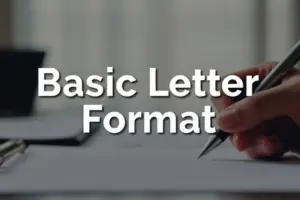How to Write a Compelling Cover Letter: Essential Steps for Success
Published: 26 Jan 2025
Hey there! Have you ever been asked to write a cover letter and found yourself staring at a blank screen, wondering how to write a cover letter that stands out? Or maybe you’ve written one before, but you’re not sure if it hit the mark. You’re definitely not alone! Many job seekers find themselves stuck in that exact spot.

The good news? Writing a cover letter doesn’t have to be overwhelming. Whether it’s for a digital submission or handwritten, the key is knowing how to structure it in a way that makes you stand out for all the right reasons. I’m here to guide you through the whole process, step by step, and by the end of it, you’ll be confident in your ability to craft a compelling cover letter that opens doors.
So, if you’re ready to turn that nervous energy into a well-written letter, let’s get started!
Step 1: What’s the Purpose of a Cover Letter?
Before we dive in, let’s pause and think: what’s the point of a cover letter? Why is it even needed? Imagine you’re walking into a room to meet someone for the first time. What do you do? You introduce yourself, talk about your background, and share why you’re excited to be there. That’s exactly what your cover letter does—it’s your introduction to a potential employer.
Here’s what it achieves:
- It says hello and tells the hiring manager a bit about you.
- It highlights your skills and why you’re perfect for the job.
- It shows that you’ve done your homework about the company.
- It adds personality to your application—something your resume can’t do alone.
So, think of your cover letter as your way of saying, “Here I am—I’m the person you’ve been looking for!”
“The future belongs to those who believe in the beauty of their dreams.”Eleanor Roosevelt
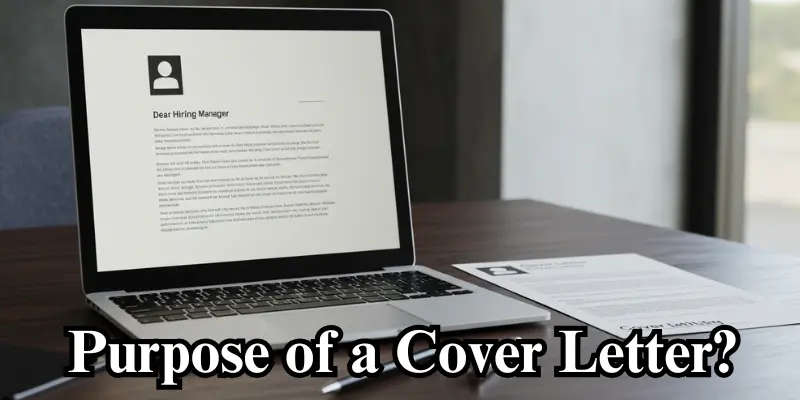
Step 2: Get Your Workspace Ready
Let’s set the scene before we start writing. Trust me, a little preparation makes a big difference.
- For Digital Writing: Open up Microsoft Word, Google Docs, or whatever tool you like to use. Keep your resume handy for reference, and maybe grab a glass of water to stay refreshed.
- For Handwritten Writing: First, grab some high-quality paper—white or cream looks very professional. Use a smooth black or blue pen (no funky colors here, please!). And find a nice, quiet spot with good lighting so you can focus and write neatly.
Are you all set? Great, let’s move on!
Step 3: Research the Company and Role
Here’s a question for you: how can you write to someone if you don’t know anything about them? That’s why research is key. Let’s get to know the company and the job you’re applying for:
- Visit the company’s website. Look for their mission, values, and latest news. What are they proud of?
- Check out their LinkedIn page or social media profiles. How do they talk about themselves?
- Read the job description carefully. What are they looking for in a candidate? Highlight the key responsibilities and qualifications.
| Pro Tip: |
|---|
Jot down three things you genuinely admire about the company or the role. This will make your letter more personal and engaging when you write it. |
Step 4: Format Like a Pro
Now, let’s make sure your cover letter looks as good as it will read. A clean, professional format shows you mean business.
- For Digital Writing:
- Stick to classic fonts like Times New Roman or Arial, size 11-12.
- Keep your margins at 1 inch on all sides.
- Keep it short and sweet—one page with three to four paragraphs is perfect.
- For Handwritten Writing:
- Use a ruler or lined paper to keep your writing neat and straight.
- Take your time. If you make a mistake, start fresh. Presentation matters!
Alright, looking sharp so far? Let’s keep going!
Step 5: Start with Your Contact Information
Here’s a question: how will the employer know how to reach you if you don’t include your details? Start your letter with your contact information at the top. Here’s how:
[Your Name]
[Your Address]
[City, State, ZIP Code]
[Your Email] | [Your Phone Number]
[Date]
For handwritten letters, write this part neatly to make a good impression right from the start.
Step 6: Address the Letter Properly
When it comes to addressing your cover letter, getting this part right can make a big impact. Let’s break it down step by step:
Start with the recipient’s name and title: If you know the hiring manager’s name, include it. For example:
[Recipient’s Name]
[Recipient’s Title]
[Company Name]
[Company Address]
- [City, State, ZIP Code]
- What if you don’t know the name? That’s okay! Use a general salutation like:
- “Dear Hiring Manager”
- “To Whom It May Concern”
- Quick Tip: If possible, take a little extra time to find the name of the person in charge of hiring. Check LinkedIn, the company’s website, or even call their office to ask. It shows initiative and attention to detail.
Before you write the body of your letter, make sure this section is clean, clear, and professional-looking.
Step 7: Write an Engaging Opening Paragraph
Here’s where you catch their attention. Imagine the hiring manager reading this and thinking, “Wow, I want to know more about this person!” Your opening should:
- Say what role you’re applying for.
- Mention where you found the job listing.
- Show some enthusiasm for the company.
Example: “I’m excited to apply for the [Position Name] role at [Company Name]. Your commitment to [specific value or achievement] inspires me, and I’m eager to contribute my skills to your team.”
Sounds good, doesn’t it? Let’s move on.
Step 8: Highlight Your Skills and Achievements
This is where you get to shine! Show them how your skills match what they’re looking for:
- Use specific examples like:
- “Managed a team of 10 to increase sales by 15%.”
- “Created a social media campaign that boosted engagement by 30%.”
- For Digital: Use bullet points if it makes your achievements stand out.
- For Handwritten: Keep sentences short and to the point.
Remember, this is your chance to connect your experiences to their needs.
Step 9: Show You Care About the Company
Here’s a tip: employers love candidates who do their homework. Mention something specific about the company that excites you.
“I admire [Company Name]’s dedication to [specific value or mission]. Your recent [specific project or achievement] aligns perfectly with my passion for
.”This shows them you’re not just looking for any job—you want to be part of their team.
“Opportunities don’t happen, you create them.”Chris Grosser
Step 10: Close with Confidence
Let’s wrap it up! End your letter with a polite and confident closing.
- Thank them for their time.
- Show enthusiasm for the next steps.
- Include your contact information again.
Example: “Thank you for considering my application. I look forward to the opportunity to discuss how my skills and experiences align with your needs. Please feel free to contact me at [Your Phone Number] or [Your Email].”
Sample Cover Letter Structure
Here’s a quick sample structure you can use:
[Your Name]
[Your Address]
[City, State, ZIP Code]
[Your Email] | [Your Phone Number]
[Date]
[Recipient’s Name]
[Recipient’s Title]
[Company Name]
[Company Address]
[City, State, ZIP Code]
Dear [Recipient’s Name or “Hiring Manager”],
[Opening Paragraph: Introduce yourself, mention the role, and express enthusiasm for the opportunity.]
[Middle Paragraph(s): Highlight your relevant skills, achievements, and experiences. Show how they align with the job requirements and the company’s goals.]
[Closing Paragraph: Thank them for their time, express interest in an interview, and include a call-to-action for the next steps.]
Sincerely,
[Your Name]
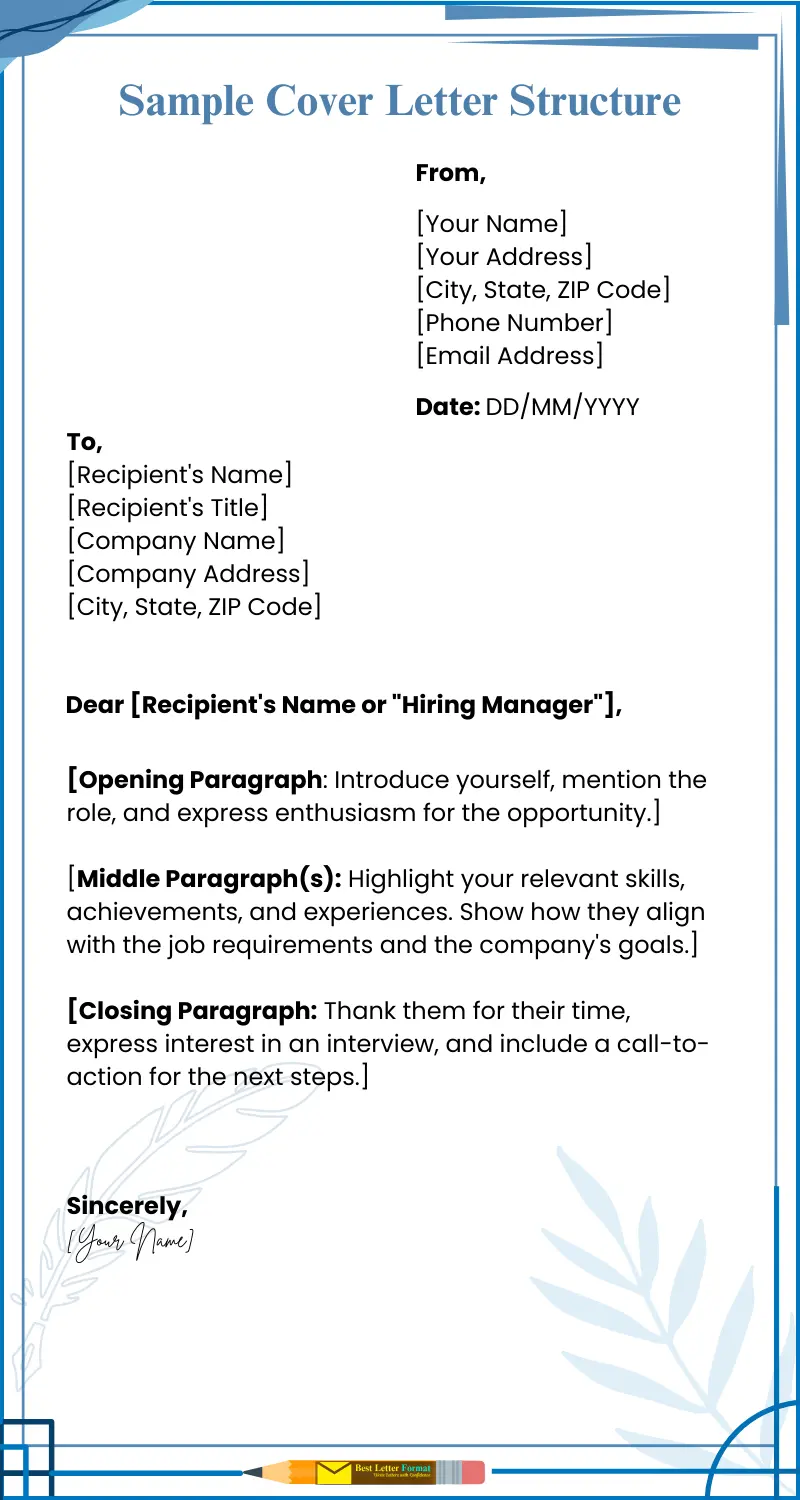
Step 11: Double-Check Your Work
Take a moment to review your masterpiece. Here’s how:
- For Digital Writing: Use tools like Grammarly or Hemingway to check for typos.
- For Handwritten Writing: Read it aloud to catch mistakes and ensure everything looks neat.
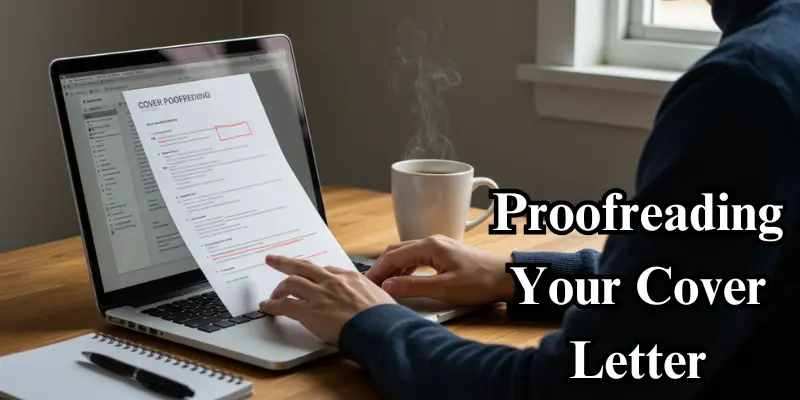
Step 12: Submit or Deliver with Care
You’re almost there! Here’s how to submit your cover letter:
- For Digital Writing: Save it as a PDF with a professional file name (e.g., “John_Doe_CoverLetter.pdf”). Follow the submission instructions in the job posting.
- For Handwritten Writing: Fold your letter neatly into an envelope. Write the recipient’s name and address clearly.
“Success is the sum of small efforts, repeated day in and day out.”Robert Collier
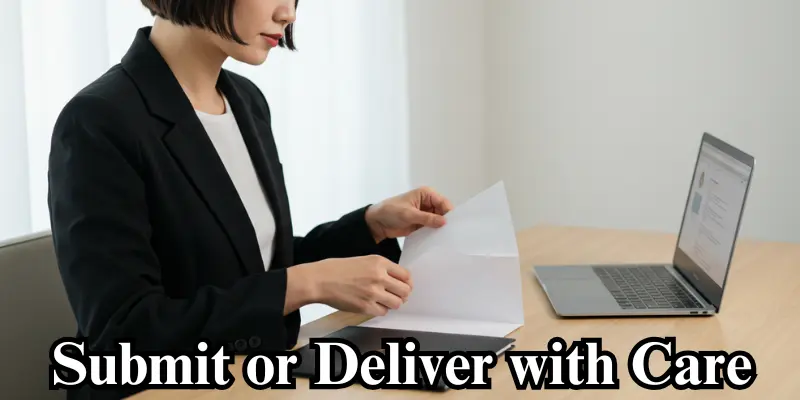
FAQs About Writing a Cover Letter
Here are some frequently asked questions that will help you further refine your cover letter writing skills:
Handwritten cover letters have a unique personal touch that can stand out, especially when applying for traditional or creative roles. It shows that you’re willing to put in the extra effort, which is always a plus in the eyes of potential employers.
Yes, absolutely! The format remains the same, whether handwritten or digital. Your contact details, salutation, body paragraphs, and closing should all follow a clean and professional structure. The only difference is the writing medium!
It’s best to stick with white or cream paper. Colored paper can sometimes come off as unprofessional, so it’s better to keep it classic and neutral for that polished look.
If you’re not confident with your handwriting, don’t worry! Practice makes perfect. Write on lined paper, and focus on keeping your letters uniform and clear. Writing slowly and carefully will help maintain neatness.
When it comes to folding, aim for a neat fold in thirds, so it fits comfortably into an envelope. This keeps your cover letter looking crisp and professional. Avoid creases by being gentle.
If you don’t know the hiring manager’s name, you can use general salutations like “Dear Hiring Manager” or “To Whom It May Concern.” But if possible, take a little extra time to find the right name—it adds a personal touch.
It’s usually better to leave salary expectations out of the cover letter, unless the job posting specifically asks for them. Focus on your qualifications and how you can add value to the company first.
Keep it short and sweet—ideally one page. A few well-crafted paragraphs should be enough to showcase your enthusiasm, skills, and qualifications. Anything longer could lose the reader’s attention.
Absolutely! In fact, customizing your cover letter for each job application is essential. Tailor your letter to highlight skills and experiences that directly align with the job requirements and the company’s goals.
End your cover letter with a confident and polite closing. Something like, “Thank you for considering my application. I look forward to the opportunity to discuss how my skills can contribute to your team.”
Conclusion
So guys, in this article, we’ve covered How to write a cover letter? in detail. Writing a cover letter may seem like a small step, but it can make a big difference in landing your next job. Here’s my personal recommendation:
- Research the company: Don’t skip this step! Knowing their values and mission will help you personalize your letter.
- Keep it concise: Hiring managers are busy, so get to the point quickly but effectively.
- Show enthusiasm: Let them know you’re excited about the role and the company.
- Highlight your skills: Match your strengths with the job requirements—they want to know how you’ll add value.
So, now that you know how to write an amazing cover letter, it’s your turn to shine! Go ahead, take action today and start crafting your cover letter that stands out. And hey, if you found this guide helpful, share it with your friends and let us know your thoughts in the comments below. Let’s keep the conversation going!

- Be Respectful
- Stay Relevant
- Stay Positive
- True Feedback
- Encourage Discussion
- Avoid Spamming
- No Fake News
- Don't Copy-Paste
- No Personal Attacks

- Be Respectful
- Stay Relevant
- Stay Positive
- True Feedback
- Encourage Discussion
- Avoid Spamming
- No Fake News
- Don't Copy-Paste
- No Personal Attacks



